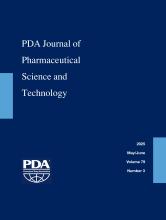Abstract
A Contamination Control Strategy (CCS) is a strategy that focuses on how to prevent contaminations with microorganisms, particles and pyrogens and manages risks to medicinal product quality and patient safety within a GMP facility. A CCS should reflect on all proactive and retrospective data within a sterile and/or aseptic and/or non-sterile manufacturing environment, to identify all sources of contamination and associated hazards and/or control measures. It should outline associated Quality Risk Assessments (QRAs), Critical Control Points (CCPs) and suggest necessary control measures. An effective way to perform QRA for CCS is adopting the Hazard Analysis Critical Control Point (HACCP) methodology, a proactive risk assessment tool. This tool can be ideally used to monitor all CCPs associated with various sources of contamination.
To keep the CCS effective, it is highly recommended to have the CCS reviewed by a multidisciplinary team and updated periodically, and to re-review it as necessary in the event particular issues arise. An annual review of the CCS effectiveness can be performed by constructing an assessment tool in the form of a report. The report provides an overview of all proactive and retrospective Quality Management System (QMS) related data that may have an impact on the CCS. This report then acts as a tool to drive continual improvement of the manufacturing and control methods, as required per EudraLex Volume 4 GMP guidelines Annex 1. This article describes a practical application of setting up an annual CCS assessment within a pharmaceutical manufacturing company to keep the CCS effective. This assessment will facilitate the process of reviewing the effectiveness of all control measures over time and facilitates escalation of issues that are not under control.
- Received September 17, 2024.
- Accepted March 12, 2025.
- Copyright © 2025, Parenteral Drug Association
PDA members receive access to all articles published in the current year and previous volume year. Institutional subscribers received access to all content. Log in below to receive access to this article if you are either of these.
If you are neither or you are a PDA member trying to access an article outside of your membership license, then you must purchase access to this article (below). If you do not have a username or password for JPST, you will be required to create an account prior to purchasing.
Full issue PDFs are for PDA members only.
Note to pda.org users
The PDA and PDA bookstore websites (www.pda.org and www.pda.org/bookstore) are separate websites from the PDA JPST website. When you first join PDA, your initial UserID and Password are sent to HighWirePress to create your PDA JPST account. Subsequent UserrID and Password changes required at the PDA websites will not pass on to PDA JPST and vice versa. If you forget your PDA JPST UserID and/or Password, you can request help to retrieve UserID and reset Password below.






